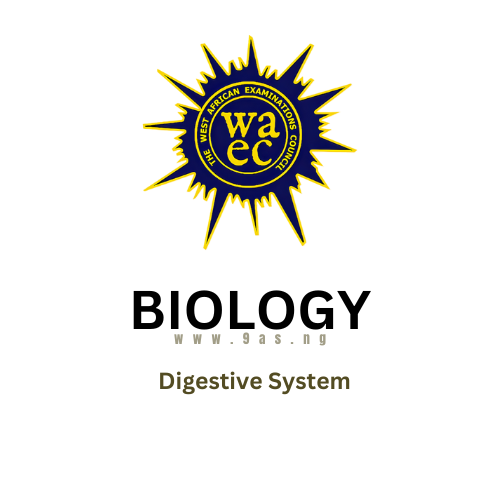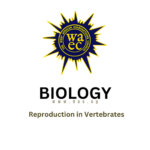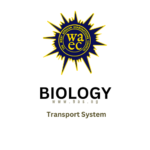OBJECTIVES
1. A person suffering from obstruction of the bile duct is advised not to eat fats and oil because
A. bile digests fats and oil. B. fats and oil can only be absorbed when bile is absent. C. bile emulsifies fats and oil. D. bile adds water to digesting food.
2.Which of the following structures is not an organ of the digestive system?
A. Oesophagus. B. pancreas. C. Stomach. D. Kidney.
3.The persistent presence of glucose in a person’s urine indicates malfunctioning of the
A. heart. B. bladder. C. pancreas. D. stomach.
4. Deamination of amino acid in the liver, produces
A. blood sugar. B. glycogen. C. bile. D. urea.
5. The equation below represents the process of glycolysis, X in the equation represents,
A. glucose diphosphate. B. glucose phosphate. C. glucose triphosphate. D. fructose phosphate.
6. Which of the following structures produces the greatest variety of digestive enzymes?
A. Salivary glands. B. Pancreas. C. Stomach. D. Colon.
7. The duodenum of a person was surgically removed. Which of the following food substances would have their digestion affected
A. Starch and protein only. B. Starch and lipids. C. Starch, peptones and maltose. D. Starch, protein.and lipids.
8. Which of the following organs of the alimentary canal is not correctly matched with its function?
A. Gall bladder – stores bile. B. Liver – stores glycogen. C. Appendix – releases enzymes. D. Teeth – grind food.
9. The function of the villi, in the alimentary canal is to
A. secrete gastric juice. B. curdle milk. C. emulsify fat. D. increase the surface area for absorption.
10. Which of the following statements best describes protein synthesis?
A. DNA is directly involved in translation B. Translocation of the ribosomes exposes a new codon for base pairing with an amino acid C. Each RNA with a particular anticodon always carries a different protein in the process D. One amino acid is always carried by more than one RNA.
11. By what process is starch converted into maltose?
A. Hydrolysis B. Condensation C. Translocation
12. In grasshopper/cockroach digestion starts from the
A. oesophagus. B. crop C. gizzard. D. midgut.
13. Which of these organs can be considered vestigial in humans but functional in other mammals? The
A. liver. B. appendix. C. rectum D. stomach.
14. In mammals, digested food is absorbed in the
A. Stomach. B. ileum. C. colon. D. duodenum.
The diagram below represents a section through the earthworm showing its alimentary system.
Use it to answer questions 15-17.

15. What is the name of the part labelled I?
A. Oesophagus. B. Nephridium. C. Pharynx. D. Intestine.
16. What is the name of the structure labelled III?
A. Gizzard. B. Crop. C. Heart. D. Coelom.
17. What is the function of the part labelled IV?
A. Production of sperm. B. Temporary storage of food. C. Mechanical grinding of food. D. Pumping blood all over the body.
18. The part of the alimentary system of a bird where grinding of maize occurs is the
A. crop. B. stomach. C. gizzard. D. cloaca.
19. The break-down of food into simple, soluble and absorbable end-products is termed
A. absorption. B. ingestion. C. nutrition. D. digestion.
20. Which of the following organisms exhibits extracellular digestion?
A. Moulds. B. Green plants. C. Algae. D. Bryophytes.
21. Which of the following is not an adaptation of the small intestine for absorption of digested food? The
A. villi are well supplied with blood and lymph vessels. B. villi are numerous and thin-walled. C. small intestine has large surface area. D. small intestine leads into the large intestine.
22. During prolonged exercises, glucose in the muscle is converted to
A. pyruvic acid. B. lactic acid. C. coenzyme. D. ethanol.
23. The digestion of proteins starts in the
A. small intestine. B. stomach. C. large intestine. D. mouth.
24. The structure that its action could result in choking when talking and eating at the same time is
A. epiglottis. B. esophagus. C. liver. D. stomach.
THEORY
1. (a) Describe the digestion of boiled fish in the gut of humans. (b) Make a diagram 8 cm -10cm long of a longitudinal section of a villus and label fully.
2. State three benefits of including roughage in the diet of human.
3. State two roles of the pancreas in digestion.
4. Make a diagram 8-10cm long to show the relative position of the following organs in the mammalian gut (i) stomach; (ii) pancreas; (iii) liver; (IV) gall bladder; (v) duodenum and label fully.
5. (a) In sequence, name the organs that constitute the alimentary canal of humans. (b) State: (i) three structural differences between the alimentary canal of a bird and human (ii) three structural similarities.
6. Describe briefly the role of the stomach in digestion.
7. Describe briefly the modifications and the mechanisms associated with the following feeding habits: (i) filter feeding in mosquito larva; (ii) parasitic feeding in tapeworm.
8. Describe the general arrangement of the viscera of a named mammal.
9. Describe the role of the following in mammalian nutrition: (i) teeth; (ii) tongue (iii) saliva (iv) stomach.
10. Name one feature that makes feeding possible in the following organisms 1. Paramecium II. Spirogyra III. Rhizopus IV Tapeworm.
11. In what form is carbohydrate stored in (i) animals (ii) plants.
12. (a) (i) State three differences between the alimentary canals of earthworm and cockroach. (ii) State three similarities between the alimentary canals of earthworm and cockroach.
13. (a) State two roles each of the following structures of the digestive system in humans (i) buccal cavity (ii) duodenum (iii) stomach. (b) Name the end product of adding dilute hydrochloric acid to sucrose.



